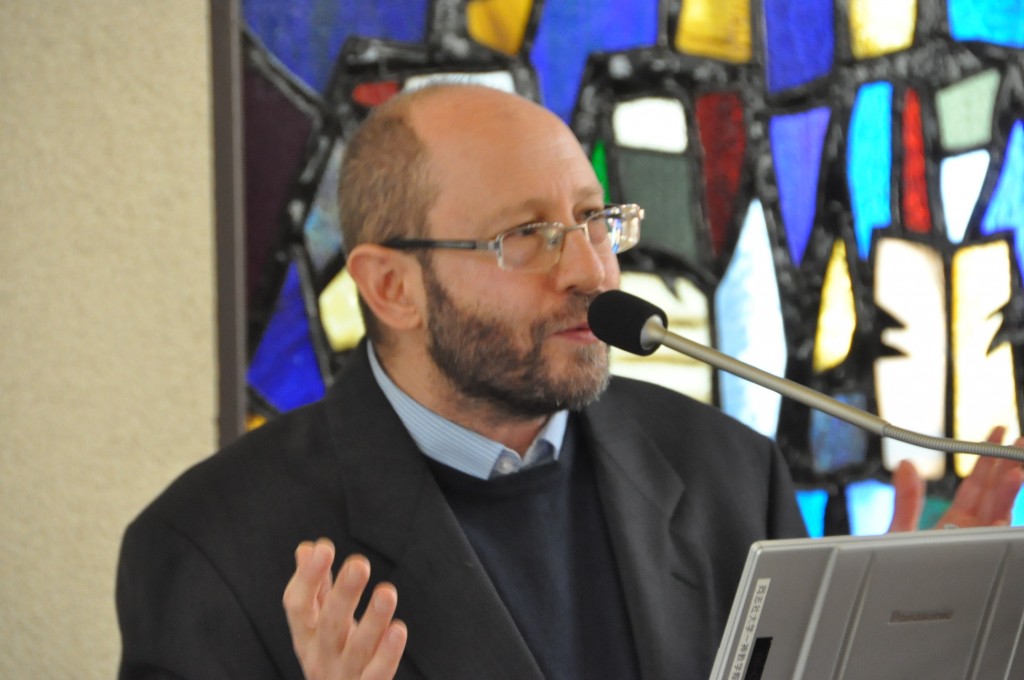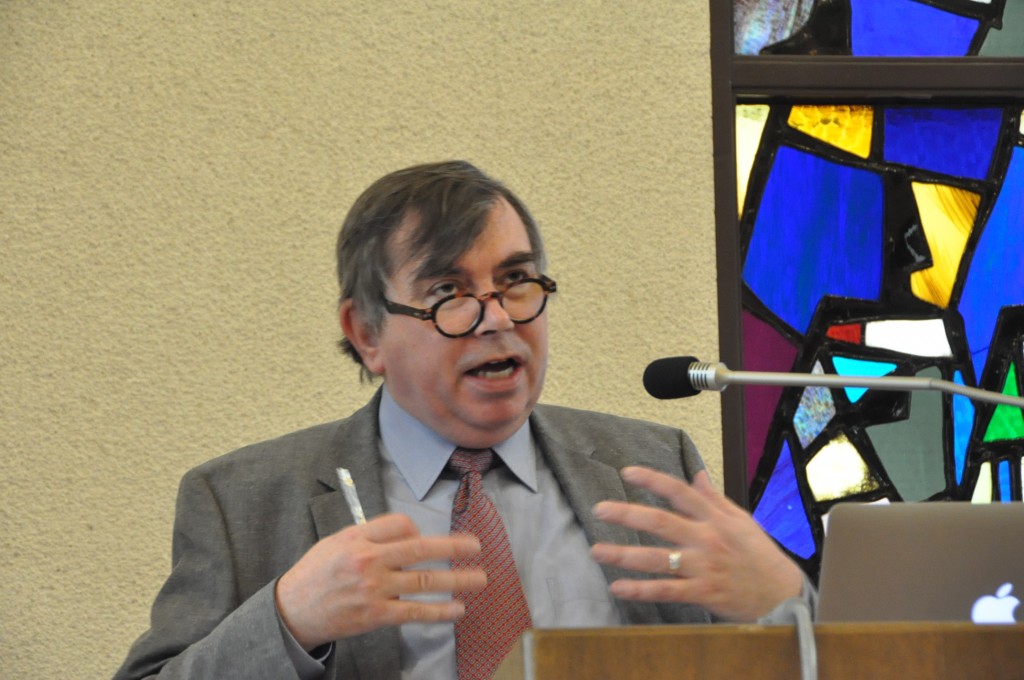Center for Interdisciplinary Study of Monotheistic Religions(CISMOR)Doshisha University
> Public Lectures > Kabbalah and Sufism – Esoteric Beliefs and Practices in Judaism and Islam in Modern TimesPublic Lectures
The 8th Annual Conference on Jewish Studies
Kabbalah and Sufism – Esoteric Beliefs and Practices in Judaism and Islam in Modern Times
| Date: |
2015/02/28 13:00-15:00 2015/03/01 13:00-15:00 |
|---|---|
| Place: | Divinity Hall Chapel, Imadegawa Campus, Doshisha University |
| Lecture: |
[2/28 SAT] Boaz Huss (Ben Gurion University) [3/1 SUN] Mark Sedgwick (Aarhus University) |
| Summary: | |
|
[2/28 SAT] In this lecture, Prof. Huss provided an overview of “Kabbalah” (which means “reception” or “something received”), and described how it was marginalized during modern times, but in the latter half of the 20th century, it flourished in an unprecedented way in a new age and postmodern context. Kabbalah refers to ancient esoteric Jewish oral transmission, texts, and practices that have existed since the 12th century. Its central doctrinal concept, known as “Theosophy,” is a theory of “Sefirot,” a Hebrew word that originally meant “numbers” and now means “divine attributes” and “emanations” of God. In Kabbalistic doctrine, the world of God is comprised of 10 Sefirot. When they clash, confusion and hardship rules the world. Humans influence Sefirot and the divine world, which is also reflected in the human world (Theurgy). The objective of humans (particularly adult Jewish males) is to restore God’s word, and the method for doing so follows Judaism’s religious doctrines and ritual conduct. From this perspective, Kabbalah can be viewed as a conservative ideology. The first Kabbalistic circles appeared in southern France during the 12th century and Spain in the early 13th century. The roots of Kabbalah are thought to be an elaboration of Gnosticism or Talmudic-period Jewish thought. The influence of Neoplatonism and Christianity has also been pointed out. In the late 13th century, Spain the Zohar (“radiance”) was written and became a central collection of texts. Due to the 1492 expulsion of Jews from Spain, Kabbalah went to various areas. Around this time, Luria created a Kabbalistic system (Lurianic Kabbalah). In the 17th and 18th century, Kabbalah spread throughout the world, and in the 18th century became normative in the Jewish world. In the 18th century, major Kabbalah movements (such as Hasidism), as well as the Jewish Enlightenment (Haskala) arose. The Haskala rejected Kabbalah and Hasidism and due to its influence, these disappeared from Jewish culture. However, it continued to have authority in the Eastern European Jewish community, which rejected Haskala. Subsequently, there were efforts to modernize Kabbalah; Yehuda Ashlag was a major figure in this effort. He created doctrines that combined Lurianic Kabbalah and communism, which became the source of contemporary Kabalistic activities. Furthermore, Jewish circles that adopted neo-romantic and nationalist ideas viewed Kabbalah and Hasidism as vital in the history of Jewish people (M. Buber, G. Scholem). Despite efforts to modernize it, it became marginalized and most went extinct. However, since the latter half of the 20th century, there has been an increased interest. The hundreds of forms of Kabbalah and Hasidism exist in various spheres found in both high-culture and sub-culture. Such neo-Kabbalah groups are characterized by diversity, mixing non-Jewish members, and have no interest in the grand narratives of Kabbalah despite passing on its tradition. They are not always connected to Jewish law, and place an emphasis on Kabbalah’s psychological and healing aspects, as well as its practical aspects, such as individual spiritual peace. Their incorporation into capitalism and commodification are pronounced. Furthermore, they also adopt new age themes and practices (meditation, Buddhism, and yoga). Prof. Huss explained that this neo-Kabbalah movement should be understood within a postmodern framework, such as the flourishing of new age culture. This relates to the weakening of the grand narrative of Western modernity; for example, the heightened interest in Kabbalah in Israel was related to the decline of Zionist and secular socialist ideologies in the 1970s. [3/1 SUN] Prof. Sedgwick first reviewed the meaning of the word “mysticism” in an Islamic context and introduced the meaning of Sufism in a classical context. He then explained the origins, development, and current state of Neo-Sufism. The basic meaning of “mysticism” was the various practices for overcoming the separation between the individual soul and God, when it was first applied to Islam in the 1670s and 1680s. The theology and philosophy of this mysticism was rooted in Dionysius the pseudo-Areopagite. His mystical theology follows the Neoplatonic tradition and one can find Neoplatonism in Islam. The theoretical framework of Sufism is Neoplatonism, which asserts “emanation” and the like. However, not all Sufis were interested in such abstractions. The fundamental five characteristics of classical Sufism are mysticism, Islam, asceticism, sociality, and saint veneration. Classical Sufism appeared in the ninth century in what is today Iran and Iraq. Sufi practice and theology included items that had no basis in the Quran and hadith. This was only an issue for a minority of people in the beginning; Sufism was the mainstream religious. However, in the nineteenth century, Muslim countries that had avoided occupation by European powers launched reform programs, and the religious mainstream gave way to the political mainstream, which saw Sufism as an obstacle to progress. In the 1950s, Sufism was ignored by elites and attacked by religious reformists. However, as the Iranian Revolution demonstrated, Islam was not rationalized away. The Islamic revival was first visible in politics, and then society. While many modern Sufists were former socialists or had their PhDs, classical Sufism generally possessed the five characteristics listed above. Neo-Sufism is essentially a border-transcending, eclectic hybrid. The first trans-regional space where Neo-Sufism developed was a Western-Islamic region inhabited by Westerners who spoke Persian and had previously lived in India. An understanding of Sufism as a perennial religion widened this space in the eighteenth century; W. Jones was a major figure in this development. The view of Sufism that he expressed in 1789 is important in two ways. First, he saw Sufism as a perennial religion that was also Iran's “primeval religion,” developed by Persians and Hindus and transmitted to ancient Greece. Second, he viewed the essence of Sufism as a pared-down monotheism and essentially the same religious system known as “Theism.” A Neo-Sufi group was established in Paris by I. Aguéli in 1911, and other ones appeared following World War I in Europe. Most of these groups included inhabitants of Western-Islamic trans-regional spaces. They were very diverse and did not necessarily possess the five characteristics of classical Sufism. These groups survived World War II and spread a new form of spirituality from the 1960s to 1970s. In the 1970s, many Sufi groups originated in the United States, and by the 1980s, Neo-Sufism had spread to a large portion of the Western world, including South America. With means of transport and communication, contact between newly trans-regional classical-style Sufism and the originally border-crossing Neo-Sufism was inevitable and relationships developed between the two. Tetsu Kitamura Researcher, Organization for Research Initiatives and Development, Doshisha University |
|
|
*This lecture will be given in English. *Admission Free, No Reservation Necessary Hosted by CISMOR & School of Theology, Doshisha University |
|

